The originators of this firm were William Shoolbred and Henry
Loveridge. According to W. H. Jones's "Story of the Japan,
Tin Plate and Iron Braziers Trades ..." (London, 1900), from
which much information on this page is taken, Shoolbred was a
Scot who came to Wolverhampton "when quite a young man. He
began his business life as a retail tailor in Dudley Street, in
partnership with his brother Robert. ... Finding he had
not enough scope for his energies in the retail tailoring trade,
he determined to make a change. ... We find Mr. Shoolbread
joined Edward Perry as a partner in the Japan trade in Paul
Street. Here Mr. Shoolbread remained for some years,
taking an active part with Perry, until an opportunity occurred
of which he promptly took advantage". (Note that Jones refers
throughout to "Shoolbread" but an original deed and the only marked item of their
wares say "Shoolbred"; the Curator has, therefore, seen fit to
adopt that spelling here.
Edward Perry was a well established japanner and Shoolbred must have
learnt the trade while he was with Perry. The opportunity which
occurred, and which seems to have prompted Shoolbred to have left Perry,
apparently quite suddenly, was that Charles Mander, having decided to
concentrate on varnish making, put his japanning business up for sale.
In 1840 he sold the business to Shoolbread on the condition that it be
removed from Mander's premises in John Street: Mander needed the room to
expand the varnish business.
According to Jones, Shoolbred took into partnership Henry
Loveridge, apparently from the start. But it may be more
complicated than that. A deed of 29th September 1869,
(Wolverhampton City Archives, Deed/372) shows Shoolbred as the sole
owner of the premises (if not of the business). The deed recites
the conveyance of the bulk on the land on which the factory stood to
Shoolbred in 1840. The deed also recites a mortgage of 1847 by
which the premises were mortgaged to one Martin Wilkes for a sum which
totalled £6,000. It seems that during the first seven years
of the enterprise money was raised from elsewhere, and the lenders may
have included Edward Perry, and that in 1847 the mortgage was taken over
by Wilkes. But up until 1869 there is no mention of Loveridge.
On the other hand a catalogue of 1855 (Wolverhampton Archives
DX-894/9/2/23) was issued in the name of Loveridge and Shoolbred.
Jones refers to Loveridge as a young man at the time and apparently a salesman who had
worked with Waltons. A firm's salesman at this time was often enough the
owner himself or a member of his family or a partner. It
is therefore possible that the firm was set up as a partnership
between Shoolbred and Loveridge but that property transactions
were carried out in Shoolbred's name and that he was seen as
holding the property in trust for the firm.
Jones relates that "The new firm soon secured a piece
of land at the bottom of Merridale Street [the site is now a green open
space, about 100 yards from the Ring Road] which at the time was
considered quite outside the town and was surrounded on all sides by
fields and gardens. They soon made plans for a large manufactory
and began to build".
|
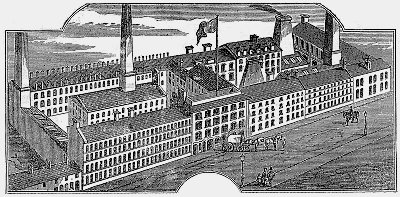 |
This depiction of the
works is taken from the 1879 advert shown below. The
variations between the parts of the building suggest that they
were not all built at the same time. |
"Fortunately for them a
good mine of excellent clay suitable for brickmaking was found on the
land. Several brick kilns were put up and plenty of cheap bricks
helped them along". Perhaps they were not simply lucky in this.
Brickkiln Street is not far away and presumably the kilns after which it
was named used clay from the spot. Shoolbread and Loveridge may
have picked this out of town site at least partly because they guessed,
or even knew, that brick making clay was to be found there.
| Merridale Works shown on
the Ordnance Survey map of 1903. Perhaps significantly the
map adds the description "Copper, Iron, Tin Plate &c". |
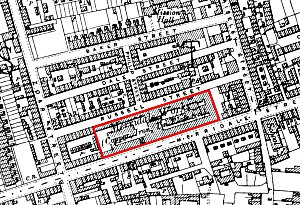 |
"Mr. Shoolbread was intensely anxious at this time.
He could be seen every morning at six o'clock watching the progress of
the brickmaking and the building of his manufactory. The handsome
pile of buildings was finished in 1848 and opened to the great joy of
the partners. During the erection of the new works the japanning
trade was carried on at the old place in John's Lane".
Jones is not good at dates but, taking these at face
value it seems to have taken eight years to build the factory.
Certainly it was a large place - but not that large. It must be
possible that it was built in stages and occupied in stages and that
after eight years the whole was finished.
Shoolbred and Loveridge could not only finance this new
works but "the japan stoves for drying were constructed on an entirely
new plan, which proved a great success". Presumably they took on
Mander's old workmen but, if they immediately occupied a large works
such as their's at Merridale, they must have quickly employed a lot
more. It is more likely that they increased their work force gradually
as the premises grew stage by stage. It is also clear, from the
1855 catalogue, that they were not solely engaged in japanning. In
that catalogue there is only one reference to japanned goods, all of the
rest of the extensive range of goods being in tinplate. It was not
uncommon for firms to issue separate catalogues for different branches
of their work and this may be the case here, with the more elaborate
items, including those on papier mache, being marketed separately.
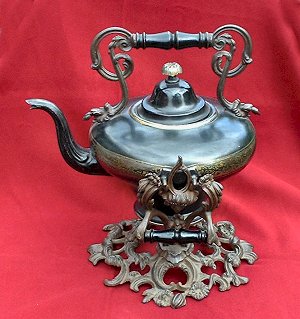 |
A large kettle in black
japan with gold decoration, cast iron stand and handle supports,
ebonised wooden handles. The whole thing stands about 15
inches high.
This piece is evidence of Loveridges'
having engaged in tin plate working and in iron casting. |
| The maker's mark and
registered design mark inside the lid of the ketttle shown above.
The firm's name is Shoolbred Loveridge and Shoolbred; the diamond
mark seems to show 16th June 1845. This may show that
Shoolbred junior joined the firm very early on; and that the firm
was in production well before 1848. |
 |
According to Jones, at some point (possibly within the first few years of the
firm's life) Shoolbred's son, also William, who had also worked at
Edward Perry's, became a partner and the firm became Loveridge,
Shoolbred, Loveridge. William died quite young and the firm then
became Loveridge and Shoolbred. Eventually William Shoolbred's
health started to fail and he, "feeling that he had a competency",
retired. This appears, from information in Henry Loveridge's
obituary, to have been in 1860. It may have been but the deed of
1869 is a conveyance of all of the firms premises from William Shoolbred
to Henry Loveridge for the sum of £10,000. The deed recites that
the original mortgage was paid off in 1860. So Shoolbred may have
given up any active interest in the firm at that time but retained
ownership of the land and buildings. Then by 1869 Loveridge was
doing well enough to buy the land and premises, thereby taking the whole
business into his sole hands. It may be significant that Shoolbred
is referred to in the deed as a "woollen draper"; so it may be that, in
some role or another, he reverted to something like his original
calling. The 1869 deed also records that, in addition to the main
factory buildings, which lay between Merridale Street and Russell
Street, the firm had also acquired the cottages numbered 98 - 102 (all
inclusive) Merridale Street, 6 messuages in Russell Street and land on
the east side of the factory,
Thus the firm became Henry Loveridge & Co. It became a joint stock company in 1903.
Unfortunately Jones is not good at giving dates and nobody has yet
scoured the sources to try to establish dates for the deaths of the two
William Shoolbreds. Henry Loveridge died in 1892.
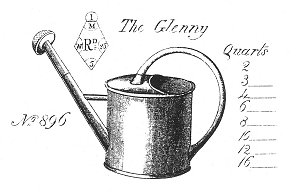 |
This watering can, from
1859, appears in an early Loveridge catalogue (in the possession
of the Wolverhampton City Council, by whose courtesy it appears
here).
The date and the shape of the handle
will be carefully noted by those who think that Christopher
Dresser designed for Loveridge. |
Of the senior William Shoolbred Jones says: "Mr.
Shoolbread was a pronounced Liberal in politics but took little active
part in town affairs; his sympathies were ever on the side of progress.
He was for many years (in fact, until his death) a Free Churchman, and a
member of the Queen Street Congregational Church. He was much
respected for his integrity and kindliness."
Somewhat more can be said about Henry Loveridge, who was
in control during the greater part of the firm's existence. An
account of him appears on another page.
By the third quarter of the 19th century Loveridge's was
one of the biggest firms of japanners in the country. It made both
tin and paper japanwares but was said to have concentrated on articles
of utility rather than ornament, though it was well represented in the
latter field by the artist Richard Stubbs. Their japanware is hard to
identify because, although some pieces have been found with the word
"Loveridge" stamped into them, they did not usually mark their japanned
work.
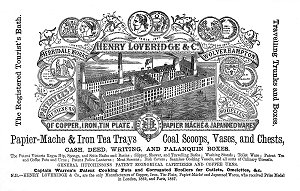 |
This advert comes from Hulley's
Directory 1879-80. This advert, and the letterhead
from 1909 (below) between them refer to medals won at
exhibitions in London 1851, Paris 1867, London 1862, New
York 1853, New Zealand 1865, Calcutta 1883-4, and Melbourne
1888. Loveridge's also supported Wolverhampton's local
Art and Industry exhibitions. |
Samuel Griffiths, in his Guide to the Iron Trade of
Great Britain, 1873, writes: "The japannery of Wolvrhampton is the
best in England. Mr. Walton's artistic designs, produced at the
Old Hall, for artistic design, elegance of shape, and excellency of
workmanship, supersede all others in the United Kingdom; there are
three or four other very large concerns, all producing first-class goods
in their own peculiar styles; the largest and most important of
these, and the greatest favourite in the London Market, is Mr. Henry
Loveridge, late Shoolbred and Loveridge's. All the japanners carry
on tin plate working" (p.94). (One can but assume that by
"supersede" Griffiths meant "transcend"; and that he used "peculiar" in
the old sense of "characteristic" or "individual"). He also
comments (p.95) that in Wolverhampton "G. & W. Underhill's monster
warehouse [which was in Castle Street] and Henry Loveridge's Japan
Works, are buildings well worth seeing; the stock of Iron at the former,
and the number of hands and activity in japan work at the latter,
surpass anything of the kind in the United Kingdom". Griffiths
always wrote with enthusiasm and at least one eye on attracting
advertising for his publications but clearly Loveridge was carrying
japanning and general tin plate work; and was doing so in one of the
largest factories in Wolverhampton. It is generally true to say
that Wolverhampton was a town of small factories and large buildings
like Loveridge's were the exception - particularly at the time when they were built.
The building was not big by the standards of, say, the Lancashire cotton
mills and if Loveridge's works surpassed anything in the United Kingdom
that would only relate to japanning works and, just possibly, tin plate
works.
| A warming plate (note the
tube at the bottom for pouring in the hot water.
The base
is of tin plate and is marked. The plate would have been
bought in, though it is just possible that Loveridge's designed
it. The style seems to be a loose version of the
aesthetic. |
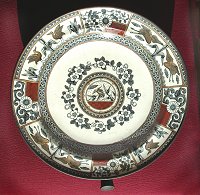 |
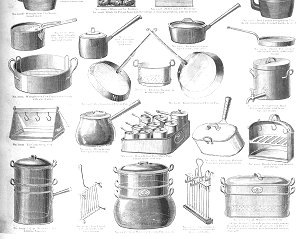 Part of the page from Silber &
Fleming's catalogue. The cooking pot in the centre of the
bottom line is marked "Loveridge".
Part of the page from Silber &
Fleming's catalogue. The cooking pot in the centre of the
bottom line is marked "Loveridge". |
The firms main concern at the start was with tin
plate wares, mainly for domestic use.
A page from the catalogue of the London wholesalers, Silber &
Fleming (undated but the late 1880s), shows cooking utensils of
cast iron. One of them shows the name "Loveridge".
There is no other firm known to which this might refer.
As the japanning trade fell away in the last quarter of the19th
century many firms turned to new products. Jones mentions
that many japanners took to making brass and copperware. |
That would be an easy step to take, especially for those
japanners who had made their own tinware for japanning: the
processes involve forming sheet metal. For Loveridges' this was
probably a matter of expanding the tinware side and adding brass and
copper wares. But japanning certainly continued right to the end,
but mainly on utilitarian pieces rather than highly decorative pieces.
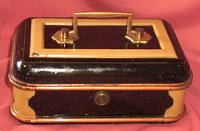 |
Japanned tin plate cash
box.
Photo courtesy of
Greg Kolojeski. |
 |
|
Certainly they went in for brass and copperware, though exactly when they
started has not been established.
This advertisement appeared in 1920.
The fact that it mentions their products in the order:
brass, copper, iron and japanned wares, may be significant of
where the core business now was. |
 |
The later history of the firm is even more speculative,
the one certainty being that it closed in 1927. Hurley's Directory of
the Hardware District 1889-90 gives a few clues. They include the
following entries:
Loveridge, Colonel Henry (H. Loveridge & Co), Elmsdale,
Wightwick. Loveridge, H & Co., Merridale Works,
Merridale Street. patentees and mnfrs of copper, iron, tin-late, papier
machie [sic] & japanned wares. Loveridge, Samuel
Esq., JP, holloware manufacturers ( T & C Clark & Co), Danes Court,
Tettenhall. Loveridge, Walter (T & C Clark & Co), Manor
Ho., Oaken.
|
It is known that Henry Loveridge himself had no
children. It seems that the ownership of the firm came into the
hands of Samuel Loveridge. Little is known about Samuel Loveridge
but he was a rich man, a partner in the T & C Clark foundry and
apparently the owner of a wide range ofpropoerties in Wolverhampton..
He appears in the 1881 census as living at Danescourt (a large house
originally built by Edward Perry) and being aged 59. This makes
his date of birth 1822 (or thereabouts). He is recorded as
"Magistrate, Ironfounder employing about 800 men, women and boys" and
his place of birth is given as Birmingham. With him at Danescourt
are his wife, Catherine, his son Walter (clerk), his second son Henry (a
student at Cambridge) and Ellen Julia Underhill, a niece aged 7. There
are also six living in servants and, at Danescourt Lodge, the groom, the
groom's wife, their three children and a boarder who is also a groom.
Henry Loveridge appears in the 1871 census as having been born in
Birmingham. It is likely that Henry and Samuel were brothers who
came to Wolverhampton (perhaps as children); one made his way in
japanning and the other in iron founding. But the Samuel Loveridge
who owned the firm in the 1920s cannot be the Samuel Loveridge born in
1822. The best guess is that he is a son of either Walter or Henry
Junior.
 |
This spittoon, in
copper, enamel and cast iron, is marked by both T & C Clark and
Loveridge and is evidence of a close association between the two
companies. |
 |
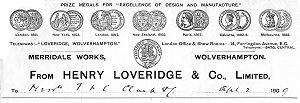 |
This letter, dated 1909, is addressed to T & C Clark. It confirms that patent kettles are in stock and offers the
standard discount of 45%This suggests that commercial
dealing between the companies were at arm's length. |
It seems from the evidence of Mr. Victor Tuckley
that in 1927 the owner of the firm was then Samuel Loveridge.
Samauel's firm was T & C Clark, a large
iron founding company, operating the Shakespeare Foundry and making,
amongst other things, cast iron cooking utensils. Tuckley
refers to Samuel as being only a figurehead and one gets the impression
that Samuel had little interest in the firm and there was no investment
or other development.
The last man to be apprenticed in Loveridge's factory was
Victor Tuckley. There is a record of his recollections of the
company between 1923 and 1927, which gives much information about the
firm in its last days.
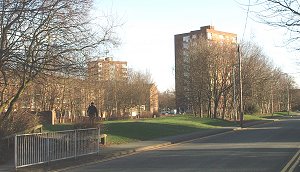 |
The site of Merridale
Works today. Merridale Street is in the foreground and
Russell Street is on the other side of the green space.
The photo was taken from Zoar Street looking towards the Ring
Road. |
After 1927 the Merridale Works was occupied by Ceandess Ltd..
This is shown by their entry and advert in the Wolverhampton Official
Handbook for 1962-3 where their address is shown as Merridale Works,
Merridale Street; and where they say that the company "moved to larger
premises in 1927 where ... the firm still operates". Whether they
occupied all or part of it is not known. It was still their
address in their last noted appearance in the 1967 Handbook.
Certainly in later times the premises had many different occupants,
including Corfield Cameras (qv), who moved into a small part of them in
1949 and moved out again in 1959, having been told by the Council that
the premises would be demolished. But it seems that the building
was not actually taken down until 1973.
 |
|
 |
|
 |
|
 |
|
 |
Return to
Art Metalware |
|
Return to the list of manufacturers |
|
Read
about Colonel Loveridge |
|
Read Mr.
V. Tuckley's account of the company |
|
Read about
Loveridge's art metalware |
|

